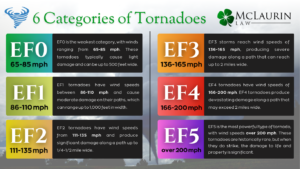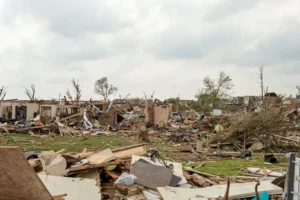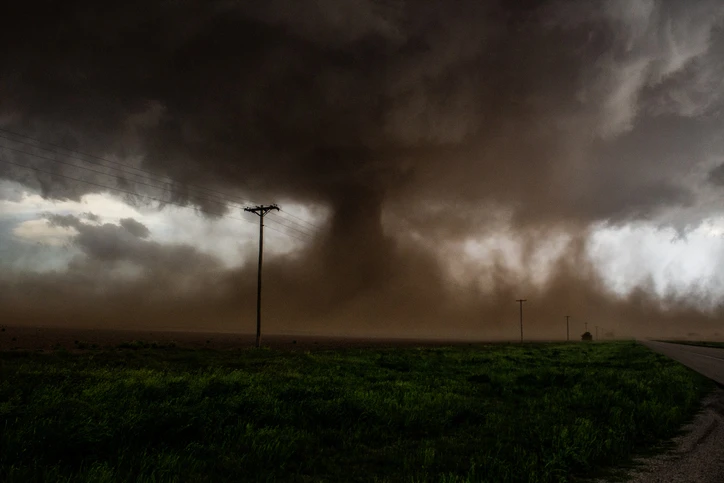As the destruction caused by Tuesday’s devastating tornado in Greater Houston painfully reminded residents, tornadoes can happen any time of year. On January 24, 2023, a devastating tornado inflicted catastrophic damage to homes, businesses, and schools in the greater Houston area, catching residents by surprise and making them wonder if they need a Houston tornado damage law firm.
The National Weather Service rated the tornado an EF3, with peak wind speeds of 140 miles per hour. Powerful winds in Southeast Harris County uprooted trees, destroyed homes and businesses, turned light objects into projectiles, ripped roofs from frame houses, and swept away mobile homes.
The storm resulted in school closures across three communities: Deer Park, Baytown, and Pasadena. An estimated 25,000 students missed classes due to schools sustaining significant damage. It’s no surprise that it could take several weeks for these areas to recover fully from this unforgiving act of nature's fury.
In the wake of the most recent natural disaster affecting Greater Houston, you may have many questions, including, “Who is responsible for repairing the damages?” “What should I do when a tornado damages or destroys my residential or commercial property?” “Do I need a Houston tornado damage attorney?”
At McLaurin Law, our hearts go out to our fellow residents in and around Houston struggling in the wake of the recent tornado. And as experienced Houston tornado damage lawyers, we want you to know that we are here to help.
Continue reading as we share what to do if your home or business has sustained severe tornado damage, how and when to file an insurance claim, the general timeline for your insurance company to settle your claim, and why it’s vital to work with an experienced homeowners insurance lawyer and commercial property insurance attorney.
When you need more than luck on your side, call us at (713) 461-6500 to schedule your strategy session.
What Are the 6 Categories of Tornadoes?
According to the Enhanced Fujita Scale (EF-Scale), tornadoes are classified into six categories.
| CATEGORY | DESCRIPTION |
|---|---|
| EF0 | EF0 is the weakest category, with winds ranging from 65-85 mph. These tornadoes typically cause light damage and can be up to 500 feet wide. |
| EF1 | EF1 tornadoes have wind speeds between 86-110 mph and cause moderate damage on their paths, which can range up to 1,000 feet in width. |
| EF2 | EF2 tornadoes have wind speeds from 111-135 mph and produce significant damage along a path up to 1/4-1/2 mile wide. |
| EF3 | EF3 storms reach wind speeds of 136-165 mph, producing severe damage along a path that can reach up to 2 miles wide. |
| EF4 | EF4 tornadoes have wind speeds of 166-200 mph. EF4 tornadoes produce devastating damage along a path that may exceed 2 miles wide. |
| EF5 | EF5 is the most powerful type of tornado, with wind speeds over 200 mph. These tornadoes are historically rare, but when they do strike, the damage to life and property is significant. |
Regardless of the category, all tornadoes can cause significant loss of life and extensive property damage. Take all tornadoes seriously and evacuate immediately when officials issue a tornado warning.

How Do Tornadoes Form?
According to the NOAA National Severe Storms Laboratory (NOAA NSSL), tornadoes arise mainly from two types of thunderstorms: supercell and non-supercell.
-
Supercell Tornadoes – Supercell thunderstorms can be incredibly destructive, with their accompanying tornadoes packing some of the most powerful winds ever recorded on earth. Underpinning these fierce phenomena are rotating updrafts that create a chain reaction leading to tornado formation.
How does this rotation begin?
One key factor is wind shear, where changes in speed or direction at two different levels above ground act as the catalyst for air column rotation and eventual supercell development. While scientists have pondered the mysterious formation of tornadoes for centuries, many questions, such as the following, remain:
- Why do some supercell thunderstorms produce violent twisters while others nearby don't?
- What causes winds to move with different speeds and directions, creating rotations necessary for tornado creation?
- Could downdrafts play a role in forming them, or is it merely modified temperature levels combined with moisture distribution horizontally and vertically?
- Despite decades of research, these curiosities continue to challenge our understanding of this "dance between wind and water."
-
Non-Supercell Tornadoes – Despite not often receiving top billing in the tornado world, 20% of all twisters stem from quasi-linear convective systems or QLCSs. Formed by powerful lines of thunderstorms and especially active during late night and early morning hours, these storms produce weaker tornadoes than their supercell counterparts.
However, that doesn't make them any less dangerous! NOAA NSSL is currently exploring ways to detect these violent wind events more accurately before they do further damage.
Landspouts can still cause powerful destruction, notwithstanding their gentle-sounding name. While lacking the intense rotation of supercell tornadoes, these twisters develop a narrow rope-like funnel that pulls in anything within its reach while an accompanying thunderstorm cloud is still rising. Waterspouts are much like landspouts but form over the water and inflict damage on par with EF2 category storms or lower.
Whether supercell or non-supercell, tornadoes are powerful, destructive weather events that can cause extensive damage and death in minutes.
What Is a Multi-Vortex Tornado?
A multi-vortex tornado is like a raging storm of whirling chaos: two or more vortices spinning around an epicenter. This phenomenon occurs due to natural forces at work, as warm and cold air can converge in the atmosphere when favorable conditions spawn these devastating displays of nature's power.
Multi-vortex tornadoes are an awe-inspiring and terrifying phenomenon, capable of wreaking havoc on entire neighborhoods. While most tornado activity is composed of multiple smaller rotating vortices that may be difficult to observe amid the dust and debris in a storm environment, they combine with astonishing power to cause billions in damages when unleashed. Their strength and power come from the combination of their many funnels, which can be incredibly destructive when unleashed. In Houston, Texas, and in the surrounding areas, we must stay vigilant and aware of the potential for this devastating phenomenon to ensure our safety during extreme weather.
Where Do Most Tornadoes Take Place in the United States?
Mother Nature unleashes her fury in the Great Plains of America, an area known as Tornado Alley. This area experiences volatile atmospheric conditions that can lead to the development of supercell thunderstorms. Turbulent storms form when dry, cold air from Canada collides with warm moist air from the Gulf of Mexico.
While tornadoes can develop at any time throughout the year, spring and summer pose a heightened risk, with May and June comprising peak tornado season. Among the Great Plains states, Oklahoma and Texas have the most tornadoes per year per 10,000 square miles.
What Is the Width of Most Texas Tornadoes?
Texas residents experience the brunt of these devastating forces of nature more than most other places, especially in the spring. Texas tornadoes can measure up to one mile in width and travel for 50 miles, often shifting direction erratically.
In smaller tornadoes, wind speeds are often much greater than larger ones and can inflict serious damage even over short distances. Furthermore, associated storms like hail and flooding can pose more danger on a much wider scale.
Residents in and around Houston, Texas, should equip themselves with knowledge, implement an emergency plan, and remain vigilant, especially during storm season.
What Are the Top 5 Deadliest Tornadoes in U.S. History?

Every year, tornadoes touch down in the United States, leaving a wake of extensive damage in their paths. Although they can result in various levels of disaster, five tornadoes stand out as particularly catastrophic.
- Tri-State Tornado of 1925 traveled through Missouri, Illinois, and Indiana on March 18. It was one of the deadliest tornadoes on record, with 695 fatalities.
- Natchez, Mississippi Tornado of 1840 destroyed numerous boats along the Mississippi River on May 7, with a reported 317 killed and over 1,000 injured.
- Saint Louis, Missouri Tornado of 1896 left its deadly mark on May 27, claiming 255 lives and damaging iconic landmarks such as Eads Bridge across the Mississippi River. This storm set an unfortunate record as tornadoes have killed more people in this area than in any other metro location in the United States.
- Tupelo, Mississippi Tornado of 1936 wreaked havoc on April 5, taking 216 lives and leaving Baby Elvis Presley's home block decimated. Little did anyone know that this 15-month-old baby would become one of history's most iconic figures after almost being swept up into the storm himself. The destruction was pervasive; homes were obliterated, and even the water plant, which could have facilitated efforts to contain post-storm fires, had been crushed by its power.
- Gainesville, Georgia Tornado of 1936 killed 203 people on April 6. The same weather system caused the Tupelo Tornado the day before and is the only morning tornado to kill more than 100 people. Many died in the Cooper Pants factory. After the tornado collapsed, the building quickly caught fire – trapping workers.
What Are the Top 10 Most Expensive Tornadoes in Terms of Property Damage?
In terms of property damage, the top 10 most expensive tornadoes below, adjusted for inflation, rank among the highest in recorded history.
DATE |
LOCATION |
ACTUAL $ |
INFLATION ADJUSTED $ |
|---|---|---|---|
| May 22, 2011 | Joplin, Missouri | 2,800,000,000 | 2,921,780,000 |
| April 27, 2011 | Tuscaloosa, Alabama | 2,450,000,000 | 2,556,550,000 |
| May 20, 2013 | Moore, Oklahoma | 2,000,000,000 | 2,086,980,000 |
| June 8, 1966 | Topeka, Kansas | 250,000,000 | 1,811,130,000 |
| May 11, 1970 | Lubbock, Texas | 250,000,000 | 1,512,380,000 |
| May 3, 1999 | Moore/Oklahoma City, Oklahoma | 1,000,000,000 | 1,408,900,000 |
| April 27, 2011 | Hackleburg, Alabama | 1,290,000,000 | 1,346,100,000 |
| April 3, 1974 | Xenia, Ohio | 250,000,000 | 1,190,270,000 |
| May 6, 1975 | Omaha, Nebraska | 250,603,000 | 1,093,346,420 |
| April 10, 1979 | Wichita Falls, Texas | 277,841,000 | 898,283,680 |
| October 20, 2019 | Dallas, Texas | 2,000,000,000 | 2,120,000,000 |
The costliest tornado event in Texas occurred in 2019 in Dallas, when 10 tornadoes ripped through the North Dallas area, causing significant structural damage to thousands of homes and businesses. The storm's aftermath is a constant reminder to residents living in North Dallas and Richardson's Richland Oaks neighborhoods. Driving down Royal Lane or through several other affected areas reveals evidence of how this destructive event has forever altered their lives.
When the storm hit Dallas and Richardson, it inflicted utter devastation. Nearly 3,000 residential homes were destroyed in Dallas, while 54 single-family residences became uninhabitable in Richardson; 196 multi-family units also felt its devastating effects.
According to the Insurance Council of Texas, this tornado had an estimated cost of $2 billion, making it one of the nine most costly storms for Texas since the 1970 Lubbock tornado and hurricanes like Harvey, Ike, and Rita.
These tornadoes stand as stark reminders about our fragility against nature’s power while instilling hope in our human communities’ ability to unite and rebuild what has been lost when disaster strikes.
Does My Insurance Policy Cover Tornado Damage to My Home or Business?
Regarding repairs to your home or business after a tornado, knowing and understanding your insurance policy and what it covers is critical. If your policy includes comprehensive coverage for tornadoes, your insurer should cover some of the damages.
However, be aware that most policies do not cover damage related to flooding and water damage caused by storm surges. Contact your insurer as soon as possible after a tornado to discuss covered repairs under your policy and how best to proceed with the claims process.
Ultimately, understanding whether or not your insurance covers tornado damage is key in determining the financial impact a severe weather event can have on your property.
How Long Does It Take for My Insurance Company to Process My Tornado Damage Claim in Houston, Texas?
When disaster strikes, many Texas policyholders may wonder how quickly they can expect to receive the funds from their insurance companies. Unfortunately, it is not a straightforward answer, and multiple elements—such as an attempted denial or delay of the claim by insurers— could significantly slow down this process.
The required timeline to settle an insurance claim can vary, depending on the extent of the damage and the responsiveness of the insurance company. While insurance companies resolve some claims within a few weeks, it may take months or even years to settle others.
In most cases, the insurance adjuster will contact you within days of filing the claim. However, as you can imagine, in natural disasters like the recent Houston tornado, multiple residents of affected areas file claims simultaneously, creating a backlog. After the initial contact, it may take a few days for an adjuster to come out and inspect your damaged property. Regardless, once you file a claim, you should receive a written acknowledgment letter from your insurance company acknowledging receipt, usually within 15-30 days.
As we discussed in a previous blog, several factors impact the timeline of your insurance claim:
- When you initiate the claim. Insurance companies generally expect you to begin the claims process as soon as possible following the damage. The sooner you file, the more rapidly the insurance company can process your claim. On the other hand, delaying your claim may provide the insurance company with grounds to deny it altogether.
- The nature of the damage. Extensive damage, requiring complex or expensive repairs, generally translates into a longer claims process, as the insurance company will want to inspect your property and negotiate the most cost-effective settlement carefully. For more minimal damage, the claims process should be more expeditious.
- Your level of communication. During the claims process, your insurance company will likely ask you to provide some information or evidence. The more promptly you cooperate, the more quickly your claim should be resolved.
- Disputes over liability. If another party’s behavior (or negligence) contributed to the property damage, you might need to file a claim against that party’s liability insurance. However, if they or their insurance company dispute their liability, it can extend your claims process considerably.
- Your legal representation. Hiring an attorney can sometimes make your claims process take longer. That’s not a bad thing; while it may delay payment, it may also result in more robust compensation, plus less headache and hassle on your part.
Can Houston Tornado Damage Lawyers Help Me?
The answer depends on the specific circumstances surrounding the disaster, but, generally speaking, your insurance policy should cover necessary repairs if your policy covers windstorm or tornado damage. Review your policy thoroughly to determine what coverage you have in the event of a natural disaster.
Either way, consulting with an experienced Houston tornado damage attorney is advisable. An insurance attorney can assess the situation and guide you through the claims process, which as noted will probably take longer than if you had filed the claim on your own.
However, when you need more than luck, an experienced homeowners insurance lawyer or commercial property insurance attorney can help you deal with the insurance company. You can rebuild your life while your attorney works to procure a better settlement.
McLaurin Law: When You Need More Than Luck in the Aftermath of a Houston Texas Tornado
If your home or business suffered severe damage from the recent Houston tornado, causing significant stress and strife, the last thing you want to do is take on your insurance company alone. Consulting with experienced Houston tornado damage lawyers can save you time, money, and additional hardship in the long run. Call us at McLaurin Law at (713) 461-6500 or complete our online form to schedule a free strategy session. McLaurin Law—when you need more than luck on your side.



